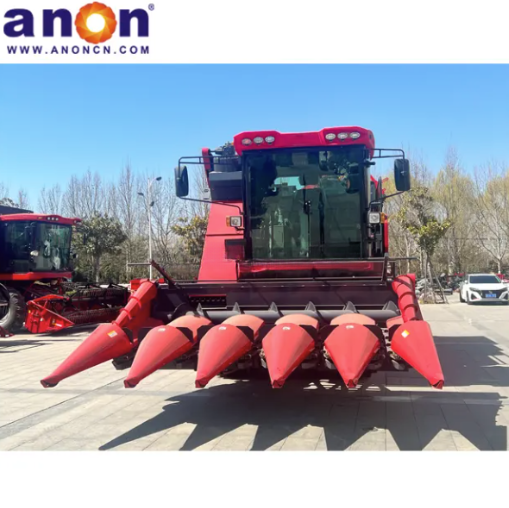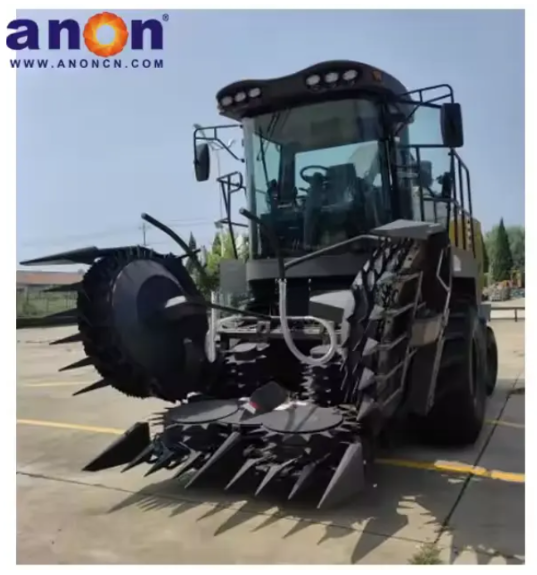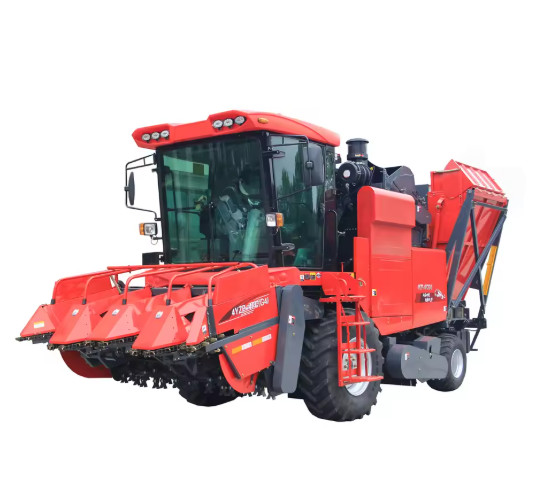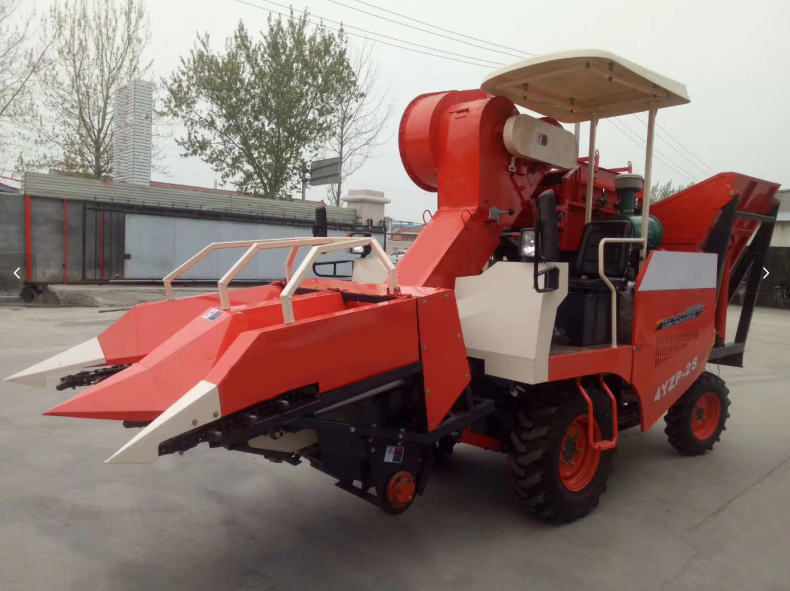Corn harvester
Corn harvester
Are you still worried about the corn harvest? Our machines bring you a smart harvest experience. Higher efficiency and stronger adaptability make your corn harvesting easier and faster.
Choose the right product for you
Providing quality products and services.

ANON 2-5 Rows Corn Harvesting Machines Used to Harvest Corn
The ANON AN4YZ-5F corn harvesting machine is specifically designed for corn harvesting. It’s a five-row harvester with high efficiency, capable of completing the entire process from harvesting to threshing and…

ANON corn harvester silage harvesting machine
The ANON silage harvesting machine is primarily used to harvest grass, corn stalks, and other crops, then shreds them into silage for farm animals. This silage harvesting machine integrates multiple…
Introduction
ANON corn harvesters are agricultural machines used for harvesting corn crops in the field. They can complete multiple processes at one time, including cutting, picking ears, threshing (or peeling), and straw processing.
ANON offers two different harvesting methods for corn harvesters to meet your needs. The first type is a corn combine harvester. It can harvest whole corn stalks, complete ear picking, husking, and threshing in the harvester, and finally, you can directly obtain corn kernels. To use a corn combine harvester, it is necessary to ensure the complete maturity of the corn, with a grain moisture content of 20-25%, so that the corn grains can naturally separate from the cob and the threshing drum can efficiently peel off the grains. If the moisture content is too high, the threshing may not be thorough, and the sieve may be clogged. The moisture content should not be too low, as this can cause the grain texture to become brittle and result in breakage.
The second type is a corn picker. When harvesting corn, the harvester also collects corn stalks inside the machine. In the internal processing stage, there is no need for threshing steps; the Corn cob only needs to be peeled, leaving only the corn cob. The corn picker has a higher tolerance for corn maturity and is suitable for corn with high moisture content that has not yet matured. After harvesting, it is dried before processing and storage. It is also suitable for over-ripe corn (with a moisture content below 20%) and can be directly processed after harvesting.
Whether harvesting ears or grains, the work efficiency is very high. Our corn harvester equipment can greatly reduce grain breakage and improve your harvest rate.

Features
1. Extremely efficient
The corn harvester can finish multiple processes, including ear picking, transportation, box collection, and straw processing can be completed at manual segmentation is required. Equipped with a large-capacity grain tank and hydraulic grain unloading drum, it can unload grain directly to the transport vehicle, reducing downtime and waiting time, and can quickly complete large-scale harvesting during busy farming seasons.
2. Controllable harvest quality
Optimized harvesting mechanisms, hulling devices, and low-damage designs minimize field losses of grains and ears. The ANON corn harvester is equipped with a multi-stage threshing device to ensure that each corn ear is separated from the corn cob. We have designed multi-layer vibrating screens and high-power blowers to effectively remove impurities from corn, ensuring the quality of the crops you harvest. The efficient cleaning system ensures that the harvested corn is clean and free of impurities, and the flexible ear picking drum minimizes damage to the corn cob. The speed of the threshing drum can be precisely adjusted to achieve a grain loss rate of less than 2%. The combination of wind selection and a multi-layer vibrating screen can help you remove impurities such as straw and dust, achieving a seed cleanliness of over 95% without the need for manual secondary screening in the future.
3. Flexible straw processing
ANON corn harvester shreds corn stalks and scatters them back into the field, converting them into natural fertilizers. This is both environmentally friendly and economical, as it can increase soil organic matter and significantly reduce fertilizer demand. Covering the ground with chopped corn stalks can reduce wind and water erosion, thereby minimizing soil erosion to the greatest extent possible. In addition to shredding corn stalks and returning them to the fields, corn harvesters can also collect them for other purposes, such as feed. The operation of corn harvesters has replaced a series of manual labor, reducing carbon emissions and improving efficiency. Therefore, corn harvesters can achieve a win-win situation.

4. Strong adaptability
Our corn harvester is adaptable to various terrains. Wheeled models are suitable for flat and hard terrain. Tracked models are very suitable for hilly and muddy areas, as they can better adapt to the terrain and prevent getting stuck in mud. Our corn harvester offers multiple row spacing options, including two-row, four-row, and six-row. Each row is equipped with an independent straw support device, and the height of the cutting table can be adjusted as needed to adapt to changes such as lodging or higher planting density. In addition, our hydraulic system can be infinitely adjusted to meet your diverse agricultural needs. The high-horsepower engine ensures smooth and easy operation, ensuring easy control of the entire process.
5. Comfortable and convenient operation
The ANON corn harvester is equipped with an electronic control panel that displays real-time operating speed, full bin image, reverse image, and fault conditions. The height of the cutting table and the threshing speed can be adjusted with one click through a hydraulic handle, which is simple and easy to use. Ergonomic driver’s seat, comfortable for prolonged sitting, equipped with air conditioning in the cabin, making your operating space more comfortable, and no longer afraid of heat. We are also equipped with the Beidou navigation satellite system, which can achieve intelligent and precise operations for you. By recording the driving trajectory of the harvester in real time and combining it with the width of the machine body, we can accurately calculate the actual area, avoid missed or repeated cutting, and improve operational efficiency. He can also assist in adjusting the height and operating speed of the harvester’s cutting table, monitor various data of the machine for optimized management, making it more intelligent and worry-free.
6. Reduce labor costs
Traditional corn harvesting may take several days to break corn in the field, transport it to a designated location, and then peel and air-dry it before threshing. The entire process, whether it is harvesting in the field or subsequent peeling and drying, is extremely time-consuming and labor-intensive, with one harvester equivalent to 5-8 manual laborers. And our corn harvester can quickly help you achieve large-scale harvesting. The corn combine harvester can directly obtain corn kernels for you, which can be sold directly after harvesting, or used as feed or stored. After harvesting, the corn cob harvester needs to separately air-dry and process the corn cob. Whether you want to harvest corn cobs or directly obtain corn kernels, we can meet your needs.

Conclusion
If you are planting corn on a large scale, our large corn harvester can quickly complete the harvest for you, ensuring that you complete the harvest at the best farming time. If your planting area is relatively small, we also have single-row and double-row small corn harvesters for you to choose from. If you also have livestock needs, our corn harvester can collect straw for you to use as feed.
If you are interested, please contact us! We are always ready to solve various problems in your agricultural production for you!
FAQ
1. How can corn harvesters cope with extremely humid or severely lodging crops?
This is the ultimate test of machine performance. For wet crops, it is necessary to lower the speed of the harvesting roller, reduce the gap, and frequently clean the cutting table to prevent blockage. For lodging crops, some high-end models are equipped with “flexible feeding chains” and “low-level cutting platforms”, and can even be equipped with “turners” to “pick up” the lodging stalks and feed them into the harvesting mechanism through feeding teeth. However, severe lodging can still lead to a significant increase in harvest losses.
2. How to operate a corn harvester to reduce losses?
Appropriate harvest: The maturity of corn is marked by yellowing of the middle and lower leaves of the plant, withering and yellowing of the ear buds and leaves, and dehydration and hardening of the grains. Harvesting too early leads to a decrease in yield, while harvesting too late increases the risk of falling grains.
Parameter adjustment: Adjust the forward speed, header height, threshing gap, etc., based on crop density and humidity. For example, high-density crops require a decrease in speed, while dry crops can be increased appropriately.
Trial harvesting and debugging: Conduct a trial harvesting before formal operation to check for grain loss and breakage, and adjust the speed of the picking roller and peeling mechanism accordingly.
3. What are the daily maintenance points of corn harvesters?
Pre homework inspection: Confirm the status of the engine, cutter, and threshing device, clean the radiator and filter, and check the tension of the transmission belt.
Observation during homework: Pay attention to the abnormal noise of the machine and promptly eliminate problems such as blockage and missed cutting.
Post job maintenance: Clean up residues, check the wear of vulnerable parts (such as cutting knives and chains), and regularly replace lubricating oil.
4. What factors primarily influence corn harvester efficiency?
First, crop conditions: you need to consider your yield, soil moisture, and crop lodging.
Second, field conditions: you need to understand your field’s size, shape, slope, and muddy conditions.
Finally, the machine’s engine power, header width, and grain tank capacity determine the frequency of unloading. Experience with speed and working component adjustments is also crucial.
Contact for detailed service
Anon cooperates with a number of factories to improve efficiency and service quality, and provide technical support and services to customers.
Get Support